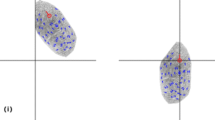Abstract
Although the use of biometrics for security access is convenient and easy to be implemented, it also introduced privacy and other security concerns when the original biometric templates are compromised. BioHash was introduced as a form of cancellable or replaceable biometrics through the integration of a set of user-specific random numbers with biometric features to address these concerns. However, the main drawback of the original form of BioHash is its inferior performance when an imposter obtains a legitimate token and uses it to claim as a genuine user (also known as the stolen-token scenario). In this paper, the problem is circumvented by a user-dependent multi-state discretization method. The experimental results on fingerprint database FVC2002 demonstrated a promising performance improvement on the stolen-token scenario when this discretization method was incorporated in the BioHash scheme. Moreover, the discretization method can render a long bit string, which is a useful feature to resist brute-force attacks. Some desired properties such as one-way transformation and diversity are also analyzed.




Similar content being viewed by others
References
Teoh ABJ, Goh A, Ngo DCL (2006) Random multispace quantisation as an analytic mechanism for BioHashing of biometric and random identity inputs. IEEE Trans Pattern Anal Mach Intell 28(12):1892–1901
Ratha N, Connell J, Bolle R (2001) Enhancing security and privacy in biometrics-based authentication systems. IBM Syst J 40(3):614–634
Ratha N, Sharat C, Connell J, Bolle R (2007) Generating cancellable fingerprint templates. IEEE Trans Pattern Anal Mach Intell 29(4):561–572
Tulyakov S, Farooq F, Govindaraju V (2005) Symmetric Hash functions for fingerprint minutiae. In: Int workshop on pattern recognition for crime prevention, security and surveillance, Bath, UK, pp 30–38
Ang R, Rei SN, McAven L (2005) Cancelable key-based fingerprint templates. In: Information security and privacy: 10th Australasian conference (ACISP 2005), Brisbane, Australia, 4–6 July, pp 242–252
Savvides M, Kumar V, Khosla PK (2004) Cancelable biometrics filters for face recognition. Int Conf Pattern Recognit 3:922–925
Boult T (2006) Robust distance measures for face-recognition supporting revocable biometrics token. In: Proceedings of the 7th international conference on automatic face and gesture recognition, pp 560–566
Teoh ABJ, Ngo DCL, Goh A (2004) Biohashing: two factor authentication featuring fingerprint data and Tokenised random number. Pattern Recognit 37(11):2245–2255
Tee C, Teoh ABJ, Goh M, Ngo DCL (2004) PalmHashing: a novel approach for dual factor authentication. Pattern Anal Appl 7(3):255–268
Kong A, Cheung K, Zhang D, Kamel M, You J (2006) An analysis of BioHashing and its variants. Pattern Recognit 39(7):1359–1368
Jain AK, Prabhakar S, Hong L, Pankanti S (2000) Filterbank-based fingerprint matching. IEEE Trans Image Process 9(5):846–859
Maio D, Maltoni D, Cappelli R, Wayman JL, Jain AK (2002) FVC2002: second fingerprint verification competition. In: Proceedings of the International Conference in Pattern Recognition, Quebec City, August, pp 11–15
Teoh ABJ, Ong TS, Ngo DCL (2003) Automatic fingerprint center point determination. In: AI 2003: advances in artificial intelligence, LNAI, vol 2903. Springer-Verlag, pp 633–640
Cover TM, Thomas JA (1991) Elements of information theory, 2nd edn. Wiley, New York
Goh A, Ngo DCL (2003) Computation of cryptographic keys from face biometrics. In: Communications and multimedia security, LNCS, vol 2828, Springer-Verlag, pp 1–13
Acknowledgment
This work was supported by the Korea Science and Engineering Foundation (KOSEF) through the Biometrics Engineering Research Center (BERC) at Yonsei University [Grant Number: R112002105080020(2009)].
Author information
Authors and Affiliations
Corresponding author
Rights and permissions
About this article
Cite this article
Teoh, A.B.J., Yip, W.K. & Toh, KA. Cancellable biometrics and user-dependent multi-state discretization in BioHash. Pattern Anal Applic 13, 301–307 (2010). https://doi.org/10.1007/s10044-009-0158-x
Received:
Accepted:
Published:
Issue Date:
DOI: https://doi.org/10.1007/s10044-009-0158-x




